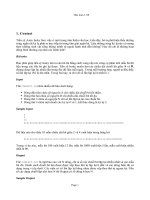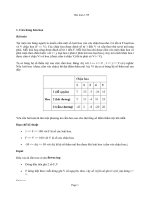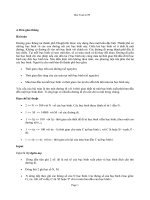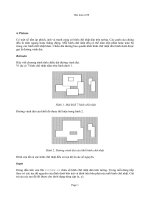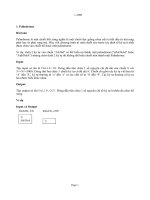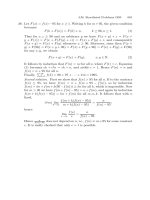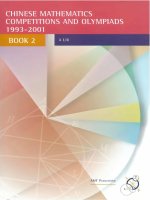Đề thi Toán quốc tế CALGARY năm 2014
Bạn đang xem bản rút gọn của tài liệu. Xem và tải ngay bản đầy đủ của tài liệu tại đây (112.75 KB, 9 trang )
<span class='text_page_counter'>(1)</span><div class='page_container' data-page=1>
THE CALGARY MATHEMATICAL ASSOCIATION
38
thJUNIOR HIGH SCHOOL MATHEMATICS CONTEST
APRIL 30, 2014
NAME: GENDER:
PLEASE PRINT (First name Last name) M F
SCHOOL: GRADE:
(9,8,7,. . . )
• You have 90 minutes for the examination. The test has
two parts: PART A — short answer; and PART B —
long answer. The exam has 9 pages including this one.
• Each correct answer to PART A will score 5 points.
You must put the answer in the space provided. No
part marks are given.
• Each problem in PART B carries 9 points. You should
show all your work. Some credit for each problem is
based on the clarity and completeness of your answer.
You should make it clear why the answer is correct.
PART A has a total possible score of 45 points. PART
B has a total possible score of 54 points.
• You are permitted the use of rough paper.
Geome-try instruments are not necessary. References
includ-ing mathematical tables and formula sheets are not
permitted. Simple calculators without programming
or graphic capabilities are allowed. Diagrams are not
drawn to scale. They are intended as visual hints only.
• When the teacher tells you to start work you should
read all the problems and select those you have the
best chance to do first. You should answer as many
problems as possible, but you may not have time to
answer all the problems.
MARKERS’ USE ONLY
PART A
×5
B1
B2
B3
B4
B5
B6
TOTAL
(max: 99)
BE SURE TO MARK YOUR NAME AND SCHOOL
AT THE TOP OF THIS PAGE.
</div>
<span class='text_page_counter'>(2)</span><div class='page_container' data-page=2>
PART A:
SHORT ANSWER QUESTIONS
(Place answers inthe boxes provided)
A1
6
A1
From the set<sub>{</sub>2,3,4,5,6,7,8,9,10,11,12<sub>}</sub>all prime numbers are removed.How manynumbers are remaining?
A2
36
A2
Alex, Betty and Chi have a total of 87 candies altogether. If Chi gives 4 candiesto Betty and 3 candies to Alex, each person then has the same number of candies.
How many candies did Chi start with?
A3
14
A3
Roll three dice so that each die shows one number from 1 to 6, and multiply thesethree numbers together. What is the smallest positive even number which cannot
be obtained?
A4
3
A4
A glass in the shape of a cylinder is 10 cm high and 15 cm around, as shown. Theglass has a logo on it occupying 2% of the curved side of the glass. What is the area
(in square cm) of the logo?
A5
</div>
<span class='text_page_counter'>(3)</span><div class='page_container' data-page=3>
A6
10
A6
A home has some fish, some birds and some cats. Altogether there are 15 heads and14 legs. If the home has more than one of each animal, how many fish are there?
Solution: Let there beF fish,B birds andC cats. From the legs we get 2B+ 4C=
14, so B+ 2C = 7 and from the heads F +B+C = 15. Now there are more than
one of each type, so there are at least 2 birds. But then there can be at most 2 cats,
soC= 2 and B = 3. From this we getF = 15<sub>−</sub>2<sub>−</sub>3 = 10.
A7
240
A7
A ceiling fan has blades 60 cm long, and rotates at a rate of 2 revolutions per second.The speed of the end of a blade can be written in the formN πcm per second, where
N is a positive integer. What isN?
Solution: The tip of a blade moves through the circumference of a circle with radius
60 cm twice in a second, so it travels 2<sub>×</sub>2π<sub>×</sub>60 cm in a second.
A8
2/3
A8
In the diagram below, similarly marked segments are equal in length. Find thelength of the segmentP Q.
Solution: Note that the three small rectangular trapezoids are congruent, so the
length of both non-vertical lines is 5. Drop a line fromP perpendicular to the base
to meet the other side inR. This makes a 3-4-5 right triangle. So the length of the
base of the trapezoids is 3 +P Q. This gives P Q+ 2<sub>×</sub>(3 +P Q) = 8. From this
6 + 3P Q= 8 and P Q= 2/3.
A9
2/9
A9
Ruby cuts 7 equal-sized round cookies from a big round piece of cookie dough, as inthe diagram below. What fraction of the original cookie dough is left?
</div>
<span class='text_page_counter'>(4)</span><div class='page_container' data-page=4>
PART B:
LONG ANSWER QUESTIONS
B1
A truck is delivering heavy goods from cityA to cityB. When travelling from AtoB the average speed of the truck is 45 km/h. On the return trip, the empty truck
has an average speed of 90 km/h. The total time spent travelling fromA toB and
returning fromB toA is 4 hours. Find the distance in km fromA toB.
The answer is 120 km.
Solution 1:
Let D be the distance from A to B. The time for the truck to go from A toB is
D/45 and the time to return from B toA isD/90, so the total time is:
total time = (time from A toB) + (time from B toA)
= D/45 +D/90
= 3D/90
= D/30.
Since the total time spent travelling fromA to B and returning from B to A is 4
hours, we haveD/30 = 4, and hence, D= 120. Therefore, the distance from A to
B is 120 km.
Solution 2:
</div>
<span class='text_page_counter'>(5)</span><div class='page_container' data-page=5>
B2
There are 2014 digits in a row. Any two consecutive digits form a number which isdivisible by 17 or 23.
(a) If the last digit is 1, then what are the possibilities for the first digit?
Solution: The first digit is 6.
The two-digit multiples of 17 are 17, 34, 51, 68 and 85. Those of 23 are 23, 46, 69
and 92. Thus, any two consecutive digitsxy must have one of the forms from
{17, 23, 34, 46, 51, 68, 69, 85, 92<sub>}</sub>.
We now can work backward from right to left working two digits at a time. Since
the last digit is 1, we start withx1. This gives 51 since no other two-digit multiple
of 17 or 23 ends in a 1. Now, withx5 we get 851. Repeating this procedure, we get
6851
46851
346851
2346851
92346851
692346851
..
.
It is now clear that the pattern 92346 of length five will repeat. Now 2014 =
402<sub>×</sub>5 + 4, so the number must be 402 blocks of 69234 followed by 6851, so the first
digit is 6.
(b) If the first digit is 9, then what are the possibilities for the last digit?
Solution: The last digit can be 4 or 7.
With the same method as before but starting with 9y we get 92, then 923, then
9234 and then 92346. At this point we have both a multiple of 17, namely 68 and a
multiple of 23, namely 69 to consider.
Case 1: Let us first pursue the path with 68. We then continue to 923468, then
9234685, and 92346851 and next 923468517, where we are stuck since we cannot
have 7y appearing.
</div>
<span class='text_page_counter'>(6)</span><div class='page_container' data-page=6>
B3
Two squares ABCD and AEFG, each with side length 25, are drawn so that the twosquares only overlap at vertex A. Suppose DE has length 14. What is the length of
BG?
Original Figure Figure for Solution 1
The answer is 48.
Solution 1:
Let P be the midpoint of ED. Then since triangle EAD is isosceles, P A is the
bisector of∠EAD. ExtendP Ato meetGBatQ. SinceAEF Gis a square,∠QAG=
90◦ <sub>−</sub><sub>∠</sub><sub>EAP</sub><sub>. Similarly</sub> <sub>∠</sub><sub>QAB</sub> <sub>= 90</sub>◦ <sub>−</sub><sub>∠</sub><sub>DAP</sub><sub>, and as</sub> <sub>P A</sub> <sub>is a bisector we get</sub>
AQ is the perpendicular bisector of GB in isosceles triangle AGB. This shows
that in fact ED and GB are parallel, and that triangle AP E is similar to triangle
GQA. Since the hypotenuse in each is of length 25, they are in fact congruent, so
GQ=AP =√252<sub>−</sub><sub>7</sub>2 <sub>= 24. Now</sub> <sub>GB</sub><sub>= 2GQ</sub><sub>= 2</sub><sub>×</sub><sub>24 = 48.</sub>
Solution 2:
This uses thelaw of cosines, which is not likely to be familiar to many of the students,
except certainly some of those who’ve done work beyond junior high. Notice that
∠DAE and ∠GAB are supplementary, since their sum plus the two right angles in
the squares gives 360◦<sub>. This means that cos(</sub><sub>∠</sub><sub>GAB) =</sub> <sub>−</sub><sub>cos(</sub><sub>∠</sub><sub>EAD). Using the</sub>
law of cosinesin the two triangles we get
142<sub>= 25</sub>2<sub>+ 25</sub>2<sub>−</sub><sub>2</sub><sub>×</sub><sub>25</sub><sub>×</sub><sub>25</sub><sub>×</sub><sub>cos(</sub><sub>∠</sub><sub>EAD)</sub>
and
GB2 = 252+ 252+ 2<sub>×</sub>25<sub>×</sub>25<sub>×</sub>cos(∠EAD).
From the first we get
cos(∠EAD) = (2<sub>×</sub>252<sub>−</sub><sub>14</sub>2<sub>)/(2</sub><sub>×</sub><sub>25</sub>2<sub>).</sub>
Using this in the second we get
GB2 = 2<sub>×</sub>252+ [(2<sub>×</sub>252)<sub>×</sub>(2<sub>×</sub>252<sub>−</sub>142)/(2<sub>×</sub>252)]
= 4<sub>×</sub>252<sub>−</sub>4<sub>×</sub>72
</div>
<span class='text_page_counter'>(7)</span><div class='page_container' data-page=7>
B4
We will call a positive integer a “2-timer” if its digits can be arranged to make anumber of shape 2<sub>×</sub>2<sub>×</sub>2<sub>× · · · ×</sub>2. For example, 2014 is a 2-timer, because its
digits can be arranged to make 1024 which is
2<sub>×</sub>2<sub>×</sub>2<sub>×</sub>2<sub>×</sub>2<sub>×</sub>2<sub>×</sub>2<sub>×</sub>2<sub>×</sub>2<sub>×</sub>2.
Positive integers cannot start with a digit 0.
(a) What is the smallest 2-timer larger than 2014? Be sure to justify your answer.
Solution: The answer is 2041.
The numbers of shape 2<sub>×</sub>2<sub>×</sub>. . .<sub>×</sub>2 (which we call powers of 2) that have exactly
four digits are
1024, 2048, 4096 and 8192.
Arranging the digits of each of these in all possible ways, the smallest number larger
than 2014 that we find is 2041, found by rearranging 1024. Since any other power of
2 would have either less than four digits or more than four digits, the same would be
true for any arrangement of the digits of such a number. So all such arrangements
would either be smaller than 2014 or larger than 2041. Therefore the answer to the
problem is 2041.
(b) What is the largest 2-timer less than 2014? Be sure to justify your answer.
Solution: The answer is 1982.
Notice that 1982 is a 2-timer less than 2014. This will be the answer if we can check
that there are none between 1982 and 2014, and this is easily done, since the number
must start with a 1 or a 2, making it a permutation of either 1024, 2048 or 8192.
None coming from 2048 can work, and it is easy to see that you cannot rearrange
1024 or 8192 starting with a 2 and get something smaller than 2014 and larger than
1982.
(c) Show that 12345678987654321 is not a 2-timer.
Solution:
</div>
<span class='text_page_counter'>(8)</span><div class='page_container' data-page=8>
B5
Three circles of radii 12 cm, 6 cm, and 6 cm each touch the other two. What is theradius in cm of the smaller circle which touches all three?
Solution: The answer is 4.
Let O be the centre of the largest circle, O<sub>1</sub>, O<sub>2</sub> the centres of the two circles of
radius 6, andC be the centre of the smallest circle, with radius r, say.
As shown in the figure on the left, the length ofCO<sub>1</sub> andCO<sub>2</sub> are both 6 +r. Also,
the length of O<sub>1</sub>O<sub>2</sub> is 12, and O is its midpoint. As shown in the figure on the
right, the length r+CO must equal the radius of the large circle. This gives that
r+CO = 12.
Applying the theorem of Pythagoras gives
(CO)2+ (OO<sub>1</sub>)2 = (CO<sub>1</sub>)2.
This gives
(12<sub>−</sub>r)2<sub>+ 6</sub>2 <sub>= (6 +</sub><sub>r)</sub>2<sub>.</sub>
Now we have
62 = (6 +r)2<sub>−</sub>(12<sub>−</sub>r)2
= 18<sub>×</sub>(2r<sub>−</sub>6).
</div>
<span class='text_page_counter'>(9)</span><div class='page_container' data-page=9>
B6
Six friends live in six houses, with a separate path connecting each pair of houses, asshown. One day, each person leaves his or her house, and visits each of the other five
houses one after the other using paths, stopping in the last house visited. Nobody
can change paths except at one of the houses. Show how all this can be done so that
every path is travelled exactly twice, once in each direction.
Solution:
Label the figure as shown on the left.
Consider the route followed by the person in house C as shown in the figure on the
right:
C A D B F E.
Note that this route uses one of the three sides of the outer triangle (CA), one of
the three sides of the inner triangle (FE), one of the three short edges connecting
the two triangles (AD), and one of the three pairs of longer edges connecting the
two triangles (DB and BF).
Thus, we may rotate this configuration to get two more routes
A B E C D F and B C F A E D,
</div>
<!--links-->
